10 commandments of obesity prevention for children
Pediatricians must do more to protect the next generation of children from the consequences of obesity before it’s too late.
Alvin N Eden, MD, FAAP

10 commandments for winning obesity battle

In 1975, I published my first childcare book Growing Up Thin, addressing the growing epidemic of childhood obesity. The obesity problem actually dates back to the 1950s, when there was a dramatic increase in the production of inexpensive, high-density, high-calorie foods. Sugar consumption rose by nearly 33%, due primarily to the use of high-fructose corn syrup.
The book was a huge success and received a great deal of publicity, but, sad to say, it failed to even make a dent into the prevalence of childhood obesity. In fact, there has been a significant increase in the prevalence of childhood obesity in the past few decades. A large-scale study recently published in the New England Journal of Medicine showed that over 25% of children entering kindergarten were either overweight or obese, and 2 out of 3 of these children remained obese as teenagers and beyond.1 The American Academy of Pediatrics also has pointed out a sharp rise in severe obesity among 2- to 5-year-olds as evidenced in the most recent 2-year cycle data from the National Health and Nutrition Examination Survey (NHANES), 2015-2016.2
Quoting from my current book Obesity Prevention for Children: Before It’s Too Late: A Program for Toddlers and Preschoolers, “What happened during the past 40-plus years?”
1. More and more meals are eaten in “fast-food” establishments.
2. Portions sizes are larger.
3. Besides TV, we now have computers, cellphones, and tablets for children, all of which increase sedentary time-what I call the SOB syndrome (Sitting On Butt syndrome).
4. Physical education time in schools has become more limited.
5. More safety issues are associated with outdoor play, such as increased automobile traffic and fear of abduction.
All these factors have resulted in the significant increase in the prevalence of childhood obesity.
Serious consequences of childhood obesity
The consequences of childhood obesity are well known. In addition to reducing overall life span, other major problems include the development of type 2 diabetes; elevated cholesterol and lipid levels; hypertension; sleep apnea; and psychologic/social difficulties attributed to a lack of self-esteem and self-worth. Further, obese children are more likely to be bullied and socially isolated.
This epidemic of childhood obesity continues unchecked despite massive attempts to stop it or at least to slow it down. What has become increasingly clear to me is that the treatment of both school-age and adolescent obesity is almost always doomed to failure. The longer a child is obese, the less likely any treatment will be effective.
I speak as a pediatrician with more than 40 years of frustration in treating overweight and obese children of all ages. Despite my best efforts, I rarely have been successful in treating an obese teenager.
The basic problem appears to be that neither the pediatric community nor the parents of young children are taking early onset obesity seriously enough. I find it difficult to convince the parents of toddlers and preschoolers who already are overweight or obese that there even is a problem. What is more upsetting is that even in high-risk families, in which 1 or both parents are obese, this lack of urgency holds true.
I firmly believe that most pediatricians do not spend enough time or effort in teaching the parents of very young children how to take the proper measures to lower the risk of obesity. Of interest is the fact that in the recommendations in the Bright Futures program of the American Academy of Pediatrics, none of the well-child visits from the 2-to 4-year list includes diet or nutrition as a priority.
Key to successfully treating obesity
The bottom line is that, in my opinion, the only way to make any significant inroads into the prevalence of childhood obesity is to NOT LET IT HAPPEN IN THE FIRST PLACE! In other words, prevention rather than treatment is the key to success.
Parental motivation plays a strong role in predicting the effectiveness of childhood obesity intervention. Family-based intervention has been found to be most effective. The earlier this intervention is started, the greater the chance of success. This has been my experience as well as the experience of most healthcare professionals dealing with overweight and obese kids.
Pediatricians are in a position to be the strongest advocates for children. We must do more to shield and protect the next generation of infants, toddlers, and preschool children from facing the physical and emotional consequences of obesity as they grow up. We must teach the parents of young children how to prevent obesity before it’s too late.
In conclusion, follow these "10 commandments for winning the obesity battle" from the last page of Obesity Prevention for Children.
References:
1. Cunningham SA, Kramer MR, Narayan KM. Incidence of childhood obesity in the United States. N Engl J Med. 2014;370(5):403-411.
2. Skinner AC, Ravanbakht SN, Skelton JA, Perrin EM, Armstrong SC. Prevalence of obesity and severe obesity in US children, 1999-2016. Pediatrics. 2018;141(3):e20173459. Epub ahead of print.
